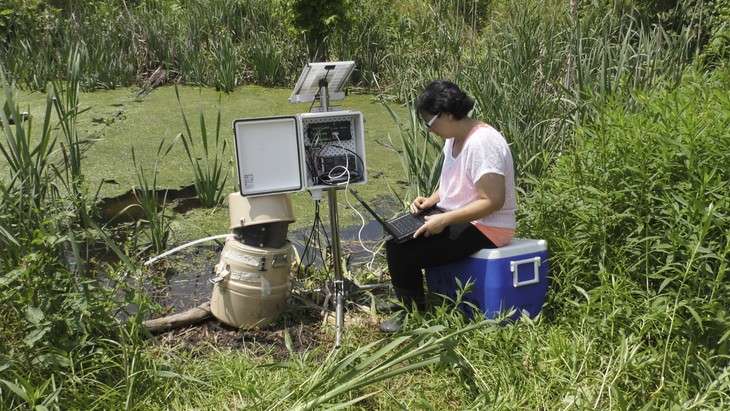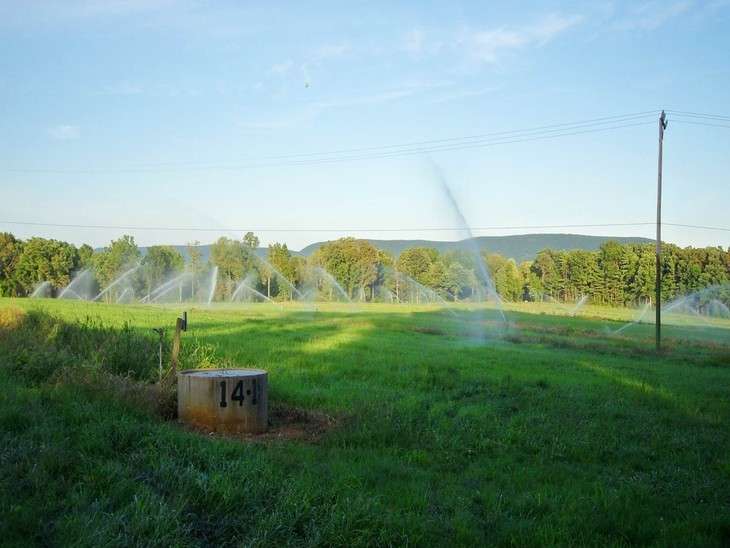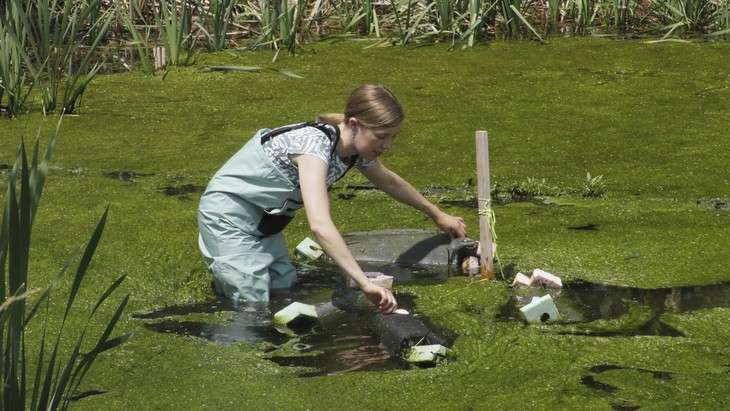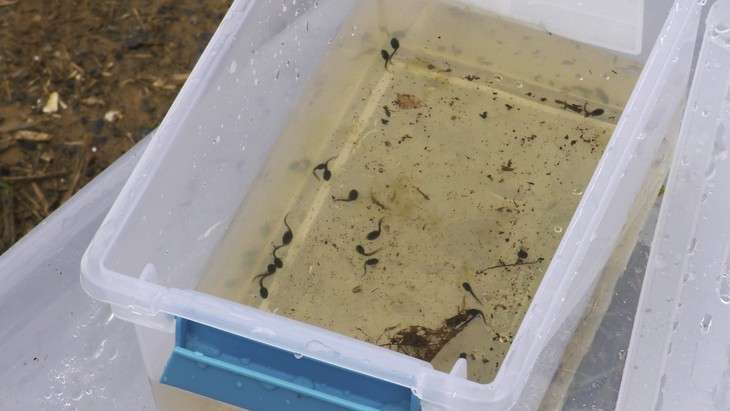Researchers use IT to study environmental sustainability of the 'Living Filter' water system

Heather Gall sprays a few sprits of tick spray around her face and arms, pulls on her baby blue waterproof waders and adjusts the straps to fit her petite frame before wading knee-deep into a pond at one of Penn State's Living Filter spray fields.
The pool of water is a result, in part, of treated sewage wastewater from the University sprayed onto forest sites and agricultural crop fields located about half mile north of University Park campus. The soil and vegetation of the Penn State-owned sites and adjoining state game lands are located within four miles of the sewage treatment plant the water comes from and act as a "living filter" to further remove contaminants in the treated wastewater.
The irrigated ponds at the Living Filter are home to distinctive plants and amphibians, and Gall, an assistant professor of agriculture and biological engineering, was there to check four test enclosures that each house 30 tadpoles she hatched from a non-irrigated control site located several miles away from the Living Filter.
The amphibian study is part of a seed grant she and her colleagues received from Penn State Institutes of Energy and the Environment and additional funding she received from the Office of Physical Plant. The grants have enabled Gall to conduct field studies to monitor the effects wastewater irrigation practices are having on the ponds and its froggy inhabitants.
"As you can imagine, the water contains a cocktail of contaminants," said Gall as she pulled one of her foot-long, cylindrical, mesh enclosures out of the water to take a peek inside.
She's referring to such emerging contaminants as over-the-counter medications, prescription drugs and anything in the personal care products used by Penn State. These synthetic and naturally occurring contaminants are not commonly monitored in the environment and often persist in the wastewater, as they remain in the effluent even after it's processed. Such impurities are suspected endocrine disruptors and can interfere with the hormone system in animals and cause amphibian populations to be skewed female.
The Living Filter has been operational for more than 50 years and is used as a cost-effective, sustainable way to restore ground-water levels and meet pollution-control requirements. The Penn State study is one of the first to attempt to determine the effects of emerging contaminants in the temporary water bodies that are critical amphibian breeding sites. Gall's research, and other studies taking place at the Living Filter grounds, will have an important influence on the development of best management practices and conservation strategies at local, regional, national and global scales.
To help with this cause, Odette Mina, a third-year Ph.D. student studying agricultural and biological engineering, assisted in the pond study by determining the levels of endocrine-disrupting compounds prevalent in the water.

Sensors attached to a data logger powered by solar panels were placed in the pond to continuously scan and log changes to the water conditions. Each day, Mina would visit the site to download the data on her computer and take water samples for hormone analysis.
"I specifically focused on estrogens and found that more than 99 percent of the samples I collected had hormones in them," said Mina.
During the first week of the study in late spring, Mina found traces of a synthetic estrogen compound used in birth control pills, patches and other contraceptives in her analysis. However, she didn't see traces of such synthetic compounds throughout the summer months, when most students are away from campus. Most of the compounds she found during that time were natural hormones, not synthetic.
"The conditions of the pond really impact what goes on with these hormones; whether they will persist or whether they will transform," said Mina.
The real-time monitoring data Mina collected showed that the ponds, which grew a thick layer of duckweed, had very low dissolved oxygen concentrations. As a result, both the natural and synthetic hormones persisted for the entire study and did not degrade between irrigation sprays at the Living Filter.
"In streams, hormones are known to have relatively short half-lives, so the fact that they persisted due to the low dissolved oxygen concentrations that we measured throughout most of our study suggests that the tadpoles were continuously exposed to hormones throughout their entire metamorphosis," said Gall.

For now, however, the exact ramifications of these hormones and other emerging contaminants on amphibian health will remain unclear. The tadpole portion of the study is on hold because the non-irrigated ponds at the control site dried up. As a result, Gall had no control data from which to compare her test tadpoles.
On the other hand, the test tadpoles in the mesh enclosures at the Living Filter had started growing the legs they'd use in the next stage of their lives. Because of this, Gall released them back to their original ponds.
"It's kind of a strange turn of events to think that the wastewater irrigation activities at the Living Filter actually saved those amphibians," said Gall.

Although the tadpole portion of the study was inconclusive, Gall is satisfied that she and her colleagues were able to develop baseline water chemistry data for a study proposal they plan to submit to the National Science Foundation, which will allow them to continue their amphibian research in the future.
"One of the over-arching questions we'd like to determine is if the presence of hormones, specifically estrogens, in these irrigated ponds is possibly causing gender skewing in the amphibian population," said Gall. "Eventually, we'd like to be able to track the frogs and make comparisons to a control group through a point where we can tell what gender they are."
So, while the initial tadpoles in the test group didn't get to offer any insight into the sustainability of the Living Filter's water system, perhaps their offspring might unlock the answer in the years to come.
Provided by Pennsylvania State University


















